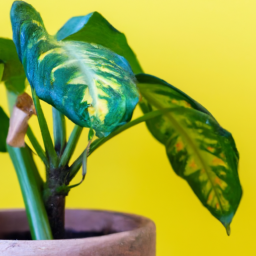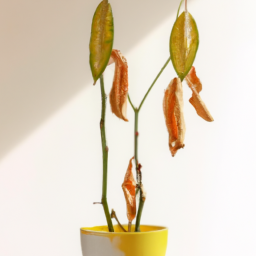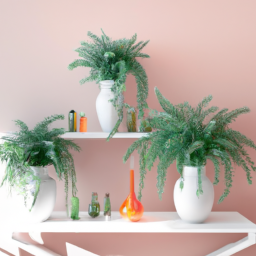
Have you ever wondered why indoor plants turn yellow? It can be frustrating to see your once vibrant green plants losing their luster and turning yellow. But fear not, because in this blog post, we will explore the reasons behind this phenomenon and provide you with some helpful tips to prevent and treat yellowing in your indoor plants. So, if you’re ready to dive into the world of plant care and uncover the secrets of why indoor plants turn yellow, keep reading!
Common Causes of Yellowing Indoor Plants
Indoor plants bring life and beauty to our homes, but it can be disheartening to see them turn yellow. Yellowing leaves are often a sign that something is amiss with your plant’s health. In this article, we will delve into the common causes of yellowing indoor plants and provide you with a step-by-step guide to address these issues.
Lack of Light
One of the primary reasons indoor plants turn yellow is due to a lack of adequate light. Just like us, plants need sunlight to thrive. When they don’t receive enough light, their leaves start to lose their vibrant green color and turn yellow.
To address this issue, you can try moving your plant to a brighter spot in your home. Ideally, place it near a window where it can receive indirect sunlight. If that’s not possible, you can also invest in artificial grow lights specifically designed for indoor plants. These lights mimic natural sunlight and can provide the necessary light your plant needs to stay healthy.
Another factor to consider is the specific light requirements of your plant species. Some plants thrive in low light conditions, while others require bright, direct light. Understanding the light preferences of your indoor plants and providing them with the appropriate conditions can prevent yellowing leaves.
Inadequate Watering
Improper watering practices can also lead to yellowing leaves in indoor plants. Overwatering or underwatering can both cause stress to your plant, resulting in yellow foliage.
When you overwater your plant, the roots become waterlogged, leading to root rot. This prevents the roots from absorbing oxygen, resulting in yellowing leaves. On the other hand, underwatering deprives the plant of essential moisture, causing the leaves to dry out and turn yellow.
To avoid overwatering, make sure your plant is in a well-draining pot and that you allow the top inch of soil to dry out before watering again. It’s important to strike a balance and provide your plant with enough water to keep the soil moist but not waterlogged.
Additionally, consider the humidity levels in your home. Some plants require higher humidity, and if the air is too dry, their leaves can turn yellow. You can increase humidity by placing a tray of water near your plant or using a humidifier.
Nutrient Deficiencies
Another common cause of yellowing indoor plants is nutrient deficiencies. Plants require a balanced mix of essential nutrients to grow and thrive. Lack of these nutrients can manifest as yellow leaves.
One of the most common nutrient deficiencies in indoor plants is nitrogen. Nitrogen is essential for healthy leaf growth, and a lack of it can result in yellowing leaves. Other nutrients like iron, magnesium, and potassium are also crucial for plant health.
To address nutrient deficiencies, you can use a balanced fertilizer specifically formulated for indoor plants. Follow the instructions on the fertilizer packaging to ensure you provide your plants with the right amount of nutrients. It’s important not to over-fertilize, as this can cause more harm than good.
Additionally, regularly inspect your plant’s leaves for signs of pests or diseases. Insect infestations or fungal infections can also lead to yellowing leaves. If you notice any signs of pests or diseases, take appropriate measures to eliminate them and prevent further damage to your plant.
By understanding the common causes of yellowing indoor plants and following these steps, you can ensure that your plants stay healthy and vibrant. Remember to provide adequate light, water your plants properly, and address any nutrient deficiencies. With a little care and attention, your indoor plants will thrive and bring joy to your living space.


Why Indoor Plants Turn Yellow
Indoor plants are a beautiful addition to any home or office space. They not only enhance the aesthetic appeal but also provide numerous health benefits. However, it can be disheartening to see your once vibrant green plants turning yellow. This discoloration is often an indication of an underlying problem that needs to be addressed. In this article, we will explore the common reasons why indoor plants turn yellow and provide you with a step-by-step guide on how to revive them.
Poor Lighting
One of the primary reasons why indoor plants turn yellow is due to inadequate lighting. Plants require a certain amount of light to carry out photosynthesis, the process by which they convert light energy into food. Insufficient light can disrupt this process and lead to yellowing leaves.
To address this issue, you need to identify the light requirements of your specific plant species. Some plants thrive in low light conditions, while others need bright, indirect light. If your plant is not receiving enough light, consider moving it to a brighter spot or providing artificial lighting using grow lights. Remember to avoid placing your plants in direct sunlight, as this can scorch the leaves.
In addition to light intensity, the duration of light exposure is also crucial. Most plants require 12-16 hours of light per day, so make sure they are not kept in complete darkness during the night. Using a timer for your grow lights can help maintain a consistent lighting schedule.
Overwatering or Underwatering
Another common reason for indoor plants turning yellow is improper watering. Both overwatering and underwatering can lead to stress and nutrient deficiencies, causing the leaves to yellow and eventually wilt.
Before watering your plants, check the moisture level of the soil by inserting your finger about an inch deep. If it feels dry, it’s time to water your plant. However, if it feels moist or wet, hold off watering until the soil dries out a bit. Different plants have different water requirements, so it’s important to research the specific needs of your indoor plants.
Overwatering is a common mistake that many plant owners make. It can lead to root rot, which inhibits the plant’s ability to absorb nutrients and water properly. To prevent overwatering, ensure that your pots have drainage holes to allow excess water to escape. Additionally, avoid leaving your plants sitting in water-filled saucers.
On the other hand, underwatering can also cause yellowing leaves. Plants rely on water for vital processes, and insufficient water supply can result in nutrient deficiencies. Remember to water your plants thoroughly, allowing the water to reach the roots. However, avoid leaving your plants in standing water, as this can also lead to root rot.
Nutrient Deficiencies
Yellowing leaves can also be a sign of nutrient deficiencies in indoor plants. Plants require a balanced supply of essential nutrients, such as nitrogen, phosphorus, and potassium, to thrive. Insufficient amounts of these nutrients can lead to yellowing leaves, stunted growth, and overall poor plant health.
Identifying nutrient deficiencies can be challenging, as different nutrients manifest in different ways. However, a general rule of thumb is to provide your plants with a balanced fertilizer specifically formulated for indoor plants. These fertilizers typically contain a mix of essential nutrients necessary for healthy growth.
When applying fertilizer, follow the instructions provided on the packaging. Overfertilization can be just as harmful as nutrient deficiencies, so it’s crucial to strike a balance. Additionally, periodically flush the soil with plain water to prevent salt buildup, which can further hinder nutrient absorption.
It’s important to note that yellowing leaves can also be caused by other factors such as pests, temperature fluctuations, or diseases. If you have ruled out the common causes mentioned above and your plant continues to deteriorate, it may be beneficial to consult a plant expert or horticulturist for further assistance.
How to Revive Yellowing Indoor Plants
Reviving yellowing indoor plants requires a systematic approach to address the underlying issues. Here is a step-by-step guide to help you revive your struggling plants:
1. Assess the Lighting Conditions
Start by evaluating the lighting conditions your plant is currently exposed to. Determine if it is receiving adequate light based on its specific requirements. If not, consider relocating the plant to a brighter spot or providing artificial lighting using grow lights. Remember to avoid direct sunlight, as it can scorch the leaves.
2. Adjust the Watering Routine
Next, review your watering routine. Check the moisture level of the soil and adjust your watering frequency accordingly. Remember to water thoroughly, allowing the water to reach the roots, but avoid overwatering or underwatering. Ensure that your pots have drainage holes and avoid leaving your plants in standing water.
3. Address Nutrient Deficiencies
If you suspect nutrient deficiencies, consider applying a balanced fertilizer specifically formulated for indoor plants. Follow the instructions provided on the packaging and avoid overfertilization. Periodically flush the soil with plain water to prevent salt buildup.
By following these steps and addressing the underlying issues, you can revive your yellowing indoor plants and restore them to their former green glory. Remember to monitor your plants closely and make adjustments as needed. With proper care and attention, your indoor plants will thrive and continue to bring beauty and freshness to your space.
In Summary
Indoor plants can add a touch of nature and beauty to any space, but sometimes they can start to turn yellow, leaving plant owners puzzled and concerned. If you’ve noticed your indoor plants losing their vibrant green color and instead developing a sickly yellow hue, don’t panic! There are several common reasons why this might be happening, and understanding them can help you revive your beloved green companions.
One of the most common causes of yellowing leaves in indoor plants is overwatering. While it’s important to keep your plants hydrated, too much water can lead to root rot and nutrient deficiencies, resulting in yellowing leaves. To prevent this, make sure your plants are potted in well-draining soil and only water them when the top inch of soil feels dry to the touch. Another possible culprit is inadequate sunlight. Just like humans, plants need sunlight to thrive, and lack of it can cause their leaves to turn yellow. If your indoor plants are not receiving enough sunlight, consider moving them closer to a window or investing in grow lights to provide them with the necessary light they need to stay healthy and green.
Frequently Asked Questions (FAQ):
Q1: Why do indoor plants turn yellow?
A1: There can be several reasons why indoor plants turn yellow. One common cause is overwatering. When plants receive more water than they need, their roots may become waterlogged, leading to yellowing leaves. Another possible reason is underwatering, where the plant doesn’t receive enough water to sustain its growth, causing yellowing as well. Nutrient deficiencies, such as lack of nitrogen, iron, or magnesium, can also cause yellowing. Lastly, inadequate light exposure or exposure to extreme temperatures can contribute to yellowing leaves in indoor plants.
Q2: How can I prevent my indoor plants from turning yellow?
A2: To prevent indoor plants from turning yellow, it’s important to provide them with the right care. First, ensure you are watering your plants appropriately by checking the soil moisture before watering. Avoid overwatering or underwatering. Additionally, make sure your plants are receiving adequate light for their specific needs. Some plants require bright, indirect light, while others thrive in low light conditions. Regularly dusting the leaves and providing proper ventilation can also help prevent yellowing. Lastly, ensure your plants are receiving the necessary nutrients by using a balanced fertilizer according to the instructions.
Q3: Can yellow leaves on indoor plants be saved?
A3: In some cases, yellow leaves on indoor plants can be saved, depending on the underlying cause. If the yellowing is due to overwatering or underwatering, adjusting your watering habits can help the plant recover. Trim off any severely damaged yellow leaves to encourage new growth. If nutrient deficiencies are causing the yellowing, you can use appropriate fertilizers to replenish the missing nutrients. However, if the yellowing is a result of a more severe issue, such as a pest infestation or disease, it may be challenging to save the affected leaves, and you may need to take more extensive measures.
Q4: Are yellow leaves always a sign of a problem?
A4: While yellow leaves on indoor plants are often a sign of a problem, they don’t always indicate a severe issue. Sometimes, it’s just a natural part of the plant’s growth cycle. Older leaves naturally turn yellow and eventually fall off. However, if a significant number of leaves are turning yellow prematurely, it’s likely a sign of an underlying problem. Regularly monitoring your plants’ overall health, including factors like watering, light exposure, and nutrient levels, can help you determine whether yellowing leaves are normal or a cause for concern.
Q5: When should I seek professional help for yellowing indoor plants?
A5: Seeking professional help for yellowing indoor plants is advisable if you’ve tried various care techniques without success or if the problem seems to be worsening. Professional horticulturists or plant specialists can provide expert advice and diagnose any underlying issues that may be causing the yellowing. They can also recommend specific treatments or interventions to save your plant. If you’re unsure about the cause of the yellowing or if you suspect a pest infestation or disease, it’s best to consult a professional to ensure the health and well-being of your indoor plants.
Dr. Olivia Green is a botanist with over two decades of experience in indoor plant cultivation. She holds a Ph.D. in Plant Biology and has dedicated her career to researching plant behavior in controlled environments. Dr. Green is passionate about helping plant enthusiasts master the art of indoor gardening through her extensive knowledge and practical insights.


